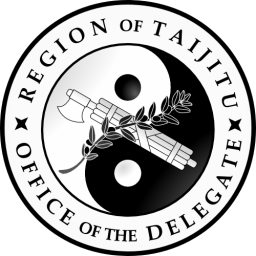Difference between revisions of "Lieutenant Delegate of Taijitu"
| Line 41: | Line 41: | ||
When a new constitution was drafted in 2010, the original proposal retained this system. This proposal was dropped and replaced with one which restored an the office of vice delegate when a broader constitutional convention voted to do so. On June 20, 2010, the constitution was formally ratified, reestablishing the office of vice delegate. | When a new constitution was drafted in 2010, the original proposal retained this system. This proposal was dropped and replaced with one which restored an the office of vice delegate when a broader constitutional convention voted to do so. On June 20, 2010, the constitution was formally ratified, reestablishing the office of vice delegate. | ||
| + | |||
| + | ==Powers== | ||
| + | |||
| + | ==Election and Recall== | ||
| + | |||
{{Navbox Government}} | {{Navbox Government}} | ||
Revision as of 01:18, 8 August 2010
| Vice delegate of Taijitu | |
|---|---|
| History | |
| Formation | Constitution of Taijitu June 20, 2010 |
| Inaugural holder | St Oz June 28, 2010 |
| Incumbent | St Oz since June 28, 2010 |
| Election | |
| Method | Instant runoff vote |
| Term length | Seven weeks, unlimited renewable |
| Last election | June 26, 2010 |
| Residence | |
| Executive forums | |
The vice delegate of Taijitu is a member of the executive branch of Taijitu's government. They are every seven weeks on the same ticket as the delegate. The office's only formal constitutional duty is to assume the office of delegate in the event that the current delegate can no longer serve for any reason. In practice, many vice delegates have gone beyond these this and served as general, high ranking members of the Cabinet, assisting the delegate in their executive responsibilities.
History
The first constitution of Taijitu also established an office of vice delegate. Like the current office, their only explicit responsibility was taking over the delegate's duties if they were unable to attend to them. However, the vice delegate under this first constitution would never assume the office proper, only assuming this powers for as long as it took to conclude a special election for delegate.
This system was put to the test when on June 14, 2007 the incumbent delegate The G Rebellion resigned and his vice delegate PoD Gunner assumed his duties. The necessity of holding another election rather than allowing the duly elected PoD Gunner to serve as delegate for the remainder of the term was soon met with skepticism. The constitution could not be amended in time to prevent the need for an election, but PoD Gunner was formally elected to replace The G Rebellion anyway. Soon afterwards, on July 20, 2007, the Senate amended the constitution to allow the vice delegate to serve out the remainder of the replaced delegate's term.
The office of vice delegate was abolished on March 27, when a new constitution was established by Sovereign Dixie as part of a coup. The new constitution was short lived, and replaced by one which closely resembled its predecessor. The office of vice delegate, however, was not revived along with the Senate. Instead, election dates were not fixed, there was simply a maximum length of time that could pass before a new election was required. If a delegate left office prematurely, a minister would serve while a new election was held. The winner was then free to serve out a full term. Regional inactivity meant that this system, while legally in place for years, was never actually fully used.
When a new constitution was drafted in 2010, the original proposal retained this system. This proposal was dropped and replaced with one which restored an the office of vice delegate when a broader constitutional convention voted to do so. On June 20, 2010, the constitution was formally ratified, reestablishing the office of vice delegate.
Powers
Election and Recall
| Government of Taijitu | |||||
|---|---|---|---|---|---|
| Legislative | Ecclesia · Citizen-Initiator | Executive | Delegate · Citizen-Diplomats · Citizen-Liaison · Armed Forces . Citizen-Sergeant | Constitution | Constitution |
| Laws | Alliance Between Taijitu and The North Pacific . Citizen-Initiator Act .Citizen-Liaison Act. Citizenship Act . Delegacy Act . Flag and Seals Act · Holidays Act . Judiciary Act . Militia Act . Noble Houses Act . Revolutionary Calendar Act . The Rejected Realms - Taijitu Treaty of Friendship and Cooperation . University of the Revolution Act | ||||
